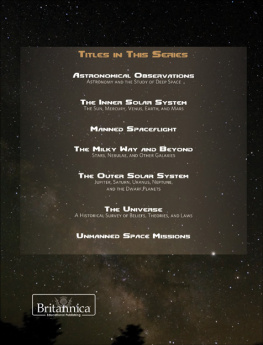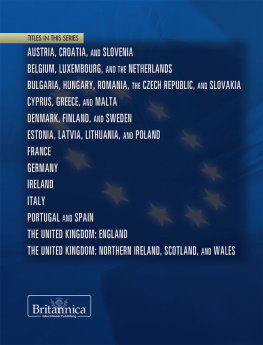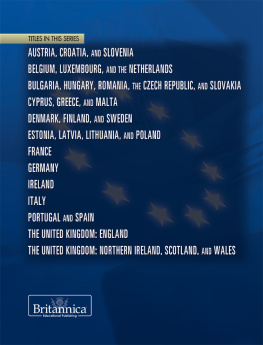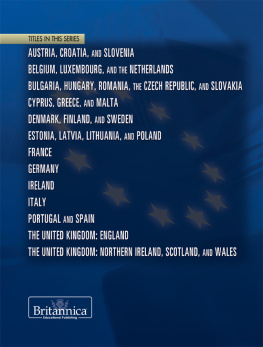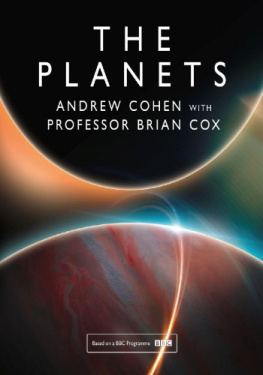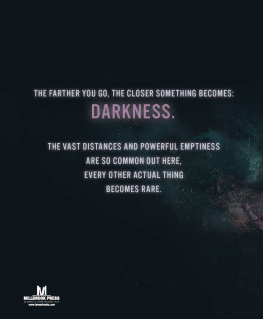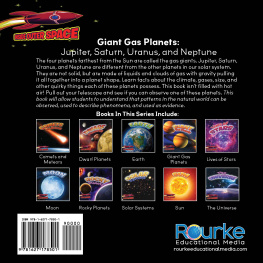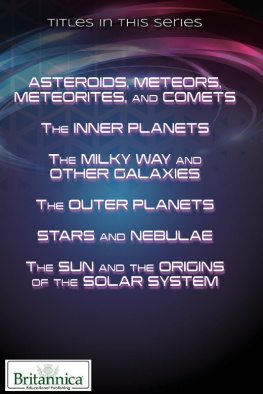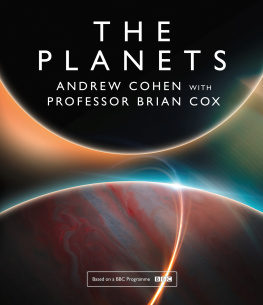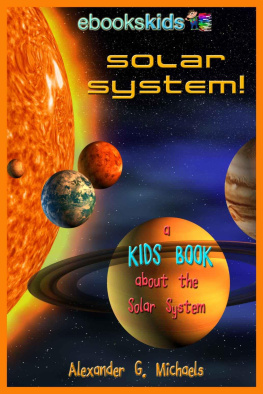THE OUTER SOLAR SYSTEM
JUPITER, SATURN, URANUS, NEPTUNE, AND THE DWARF PLANETS
AN EXPLORERS GUIDE TO THE UNIVERSE
THE OUTER SOLAR SYSTEM
JUPITER, SATURN, URANUS, NEPTUNE, AND THE DWARF PLANETS
EDITED BY ERIK GREGERSEN, ASSOCIATE EDITOR, ASTRONOMY AND SPACE EXPLORATION

Published in 2010 by Britannica Educational Publishing
(a trademark of Encyclopdia Britannica, Inc.)
in association with Rosen Educational Services, LLC
29 East 21st Street, New York, NY 10010.
Copyright 2010 Encyclopdia Britannica, Inc. Britannica, Encyclopdia Britannica, and the Thistle logo are registered trademarks of Encyclopdia Britannica, Inc. All rights reserved.
Rosen Educational Services materials copyright 2010 Rosen Educational Services, LLC.
All rights reserved.
Distributed exclusively by Rosen Educational Services.
For a listing of additional Britannica Educational Publishing titles, call toll free (800) 237-9932.
First Edition
Britannica Educational Publishing
Michael I. Levy: Executive Editor
Marilyn L. Barton: Senior Coordinator, Production Control
Steven Bosco: Director, Editorial Technologies
Lisa S. Braucher: Senior Producer and Data Editor
Yvette Charboneau: Senior Copy Editor
Kathy Nakamura: Manager, Media Acquisition
Erik Gregersen: Associate Editor, Astronomy and Space Exploration
Rosen Educational Services
Jeanne Nagle: Senior Editor
Nelson S: Art Director
Nicole Russo: Designer
Introduction by Greg Roza
Library of Congress Cataloging-in-Publication Data
Outer solar system: Jupiter, Saturn, Uranus, Neptune, and the dwarf planets / edited by Erik Gregersen.1st ed.
p. cm.(An explorers guide to the universe)
In association with Britannica Educational Publishing, Rosen Educational Services.
Includes index.
ISBN 978-1-61530-051-8 (eBook)
1. Solar systemPopular system. 2. SattelitesPopular system. 3. Kuiper BeltPopular
system. I. Gregersen, Erik.
QB501.2.O98 2010
523.2dc22
2009036104
On the cover: A highly visible ring system differentiates Saturn from the other planets of the outer solar systemJupiter, Neptune, Uranusand the dwarf planet Pluto. Cover photo: www.istockphoto.com/sololos
INTRODUCTION

As they tumble into Earths orbit, stony or metallic chunks of space matter known as meteors burst into friction-induced flame, creating a fiery show in the night sky. NASA/Getty Images
A fter hundreds of years of observation, theorizing, exploration, and data collection, the universe is still a mysterious place. Numerous cosmic questions remain unanswered despite the scientific and technological advances made since the telescope was invented in the 1600s. But we are learning more about the cosmos all the time through intense examination of the solar system in which we live.
Still, learning about the outer solar system has proved to be difficult, to say the least. What is known about the farthest reaches of our solar system is discussed, at great length and in fine detail, in this book.
Scientists have launched many spacecraft into orbit. Manned spacecraft have traveled as far as the moon. Unmanned probes have approached most of the planets and even landed on Mars. These probes tell scientists more about the solar system than we could ever learn with telescopes alone. In 1977, the Voyager 1 probe was sent into space for the purpose of exploring Jupiter and Saturn. Other probes were sent in the years that followed. It took decades for these probes to reach the most distant planets and send back data about them. Presently, Voyager 1 is the farthest man-made object from Earth; it is approaching the edge of the known solar system, and scientists hope it will gain new information about the mystifying region known as the Kuiper Belt.
The Voyager and other missions represent the limit of our physical reach within the cosmos. For now, we depend on the data they have collected to gain a better understanding of the outer solar system.
Beyond the orbit of Marswhich represents the planetary boundary between the inner and outer solar systemis a ring of asteroids orbiting the Sun. The asteroid belt contains rocky objects left over from the formation of the solar system. The asteroids range in size from hundreds of kilometers in diameter to dust-sized particles. The largest asteroid in the asteroid belt, Ceres, is considered a dwarf planet. It was the first asteroid ever discovered. By 2009, more than 450,000 asteroids had been discovered.
While most asteroids orbit the sun in the main belt between Mars and Jupiter, some stray closer to Earth. These are called near-Earth asteroids (NEAs). Most NEAs are still far from Earth, but some actually cross Earths orbit, making them potentially deadly to life on Earth.
Smaller-sized asteroids are often called meteoroids. This term is also often reserved for asteroids that collide with other objects, or those that have the potential to do so. If a meteoroid comes close enough to Earth, it might enter our atmosphere. The swiftly moving meteoroid becomes so hot that it glows, creating a visible phenomenon we call a meteor or shooting star. A meteor that reaches the ground before burning up is called a meteorite. Large meteorites can create deep impressions in the ground called impact craters, like those we can see on the moons surface.
The first of the outer planets is the fifth planet from the SunJupiter. It is the most massive planet in the solar system and is larger than all the other planets combined. This gas giant has a diameter of about 143,000 km (88,900 miles). Jupiters mean orbital distance is 778 million km (483 million miles), and it takes about 12 years to make one rotation around the sun.
We can see Jupiters atmosphere from Earth with a telescope. It is well known for its bands of colour. Close-up views of Jupiter have shown quickly moving clouds and giant, cyclonelike storms. The Great Red Spota cyclone larger than Earth and Mars togetheris perhaps Jupiters most notable feature. The clouds around Jupiter contain numerous substances, particularly pure hydrogen and helium, methane, ammonia, and water.
Jupiter doesnt have a solid surface. Since scientists cannot see past its atmosphere, they have come up with theories about what lies below it. Jupiter has a significant magnetic field and constantly radiates radio waves. The planet also creates more energy than it receives from the Sunanother fact that continues to intrigue scientists.
To date, more than 60 moons have been discovered in orbit around Jupiter, and there are likely more. The largest moon in the solar systemGanymedeis larger than Mercury! Several of these worlds are as interesting to scientists as the planet they circle. Jupiter also has a ring of ice and dust similar to but much smaller than those around Saturn.
You probably recognize Saturn as the ringed planet. It is the second-largest planet in the solar system with a diameter of 120,536 km (74,898 miles). At a mean orbital distance of 1,427,000,000 km (887 million miles), it takes Saturn nearly 30 years to make one trip around the Sun.
Saturns atmosphere is similar to Jupiters, but it is much less active. Like Jupiter, Saturn does not have a solid surface. It is surrounded by a dense, complex layer of clouds that appear as light-brown bands circling the planet. Storms are sometimes visible as well. Saturn has the most hydrogen-rich atmosphere of all the planets with 91 percent hydrogen and 6 percent helium. Common compounds include ammonia and methane, among smaller traces of others. Scientists think Saturns interior is made up mainly of liquid hydrogen. The core is probably a liquid, metallic substance. Saturns magnetic field is probably due to motions in its metallic core.
Next page
